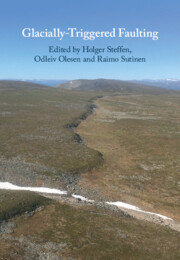Book contents
- Glacially-Triggered Faulting
- Glacially-Triggered Faulting
- Copyright page
- Contents
- Figures
- Tables
- Contributors
- Preface
- Part I Introduction
- Part II Methods and Techniques for Fault Identification and Dating
- 3 Earthquake-Induced Landforms in the Context of Ice-Sheet Loading and Unloading
- 4 The Challenge to Distinguish Soft-Sediment Deformation Structures (SSDS) Formed by Glaciotectonic, Periglacial and Seismic Processes in a Formerly Glaciated Area
- 5 Glacially Induced Fault Identification with LiDAR, Based on Examples from Finland
- 6 Fault Identification from Seismology
- 7 Imaging and Characterization of Glacially Induced Faults Using Applied Geophysics
- 8 Dating of Postglacial Faults in Fennoscandia
- 9 Proposed Drilling into Postglacial Faults
- Part III Glacially Triggered Faulting in the Fennoscandian Shield
- Part IV Glacially Triggered Faulting at the Edge and in the Periphery of the Fennoscandian Shield
- Part V Glacially Triggered Faulting Outside Europe
- Part VI Modelling of Glacially Induced Faults and Stress
- Part VII Outlook
- Index
- References
8 - Dating of Postglacial Faults in Fennoscandia
from Part II - Methods and Techniques for Fault Identification and Dating
Published online by Cambridge University Press: 02 December 2021
- Glacially-Triggered Faulting
- Glacially-Triggered Faulting
- Copyright page
- Contents
- Figures
- Tables
- Contributors
- Preface
- Part I Introduction
- Part II Methods and Techniques for Fault Identification and Dating
- 3 Earthquake-Induced Landforms in the Context of Ice-Sheet Loading and Unloading
- 4 The Challenge to Distinguish Soft-Sediment Deformation Structures (SSDS) Formed by Glaciotectonic, Periglacial and Seismic Processes in a Formerly Glaciated Area
- 5 Glacially Induced Fault Identification with LiDAR, Based on Examples from Finland
- 6 Fault Identification from Seismology
- 7 Imaging and Characterization of Glacially Induced Faults Using Applied Geophysics
- 8 Dating of Postglacial Faults in Fennoscandia
- 9 Proposed Drilling into Postglacial Faults
- Part III Glacially Triggered Faulting in the Fennoscandian Shield
- Part IV Glacially Triggered Faulting at the Edge and in the Periphery of the Fennoscandian Shield
- Part V Glacially Triggered Faulting Outside Europe
- Part VI Modelling of Glacially Induced Faults and Stress
- Part VII Outlook
- Index
- References
Summary
Numerous methods have been applied to dating postglacial faults in Fennoscandia. Traditionally, these range from determining relative ages based on cross-cutting relationships to determining absolute ages based on stratigraphy and radiocarbon dates. More recently, however, direct dating of fault scarps using terrestrial cosmogenic nuclide dating has been attempted.
The benefits and limitations of these methods are described citing examples from recent literature. Subsequently, the dates themselves are discussed in the context of the longstanding hypothesis that postglacial faults in Fennoscandia ruptured only once during or shortly after deglaciation. While each of the studies reviewed applies only to the investigated faults, collectively recent literature indicates a longer lasting and more complex spatial and temporal history of postglacial faulting in the Fennoscandian Shield area.
Keywords
- Type
- Chapter
- Information
- Glacially-Triggered Faulting , pp. 133 - 150Publisher: Cambridge University PressPrint publication year: 2021



